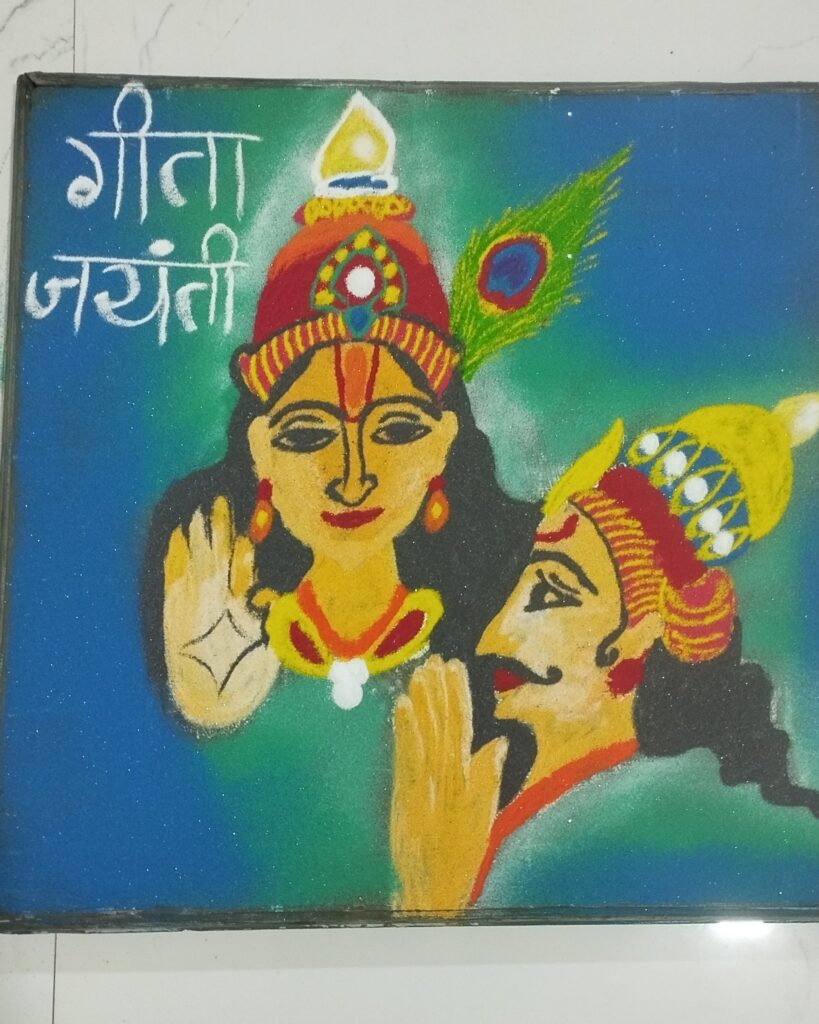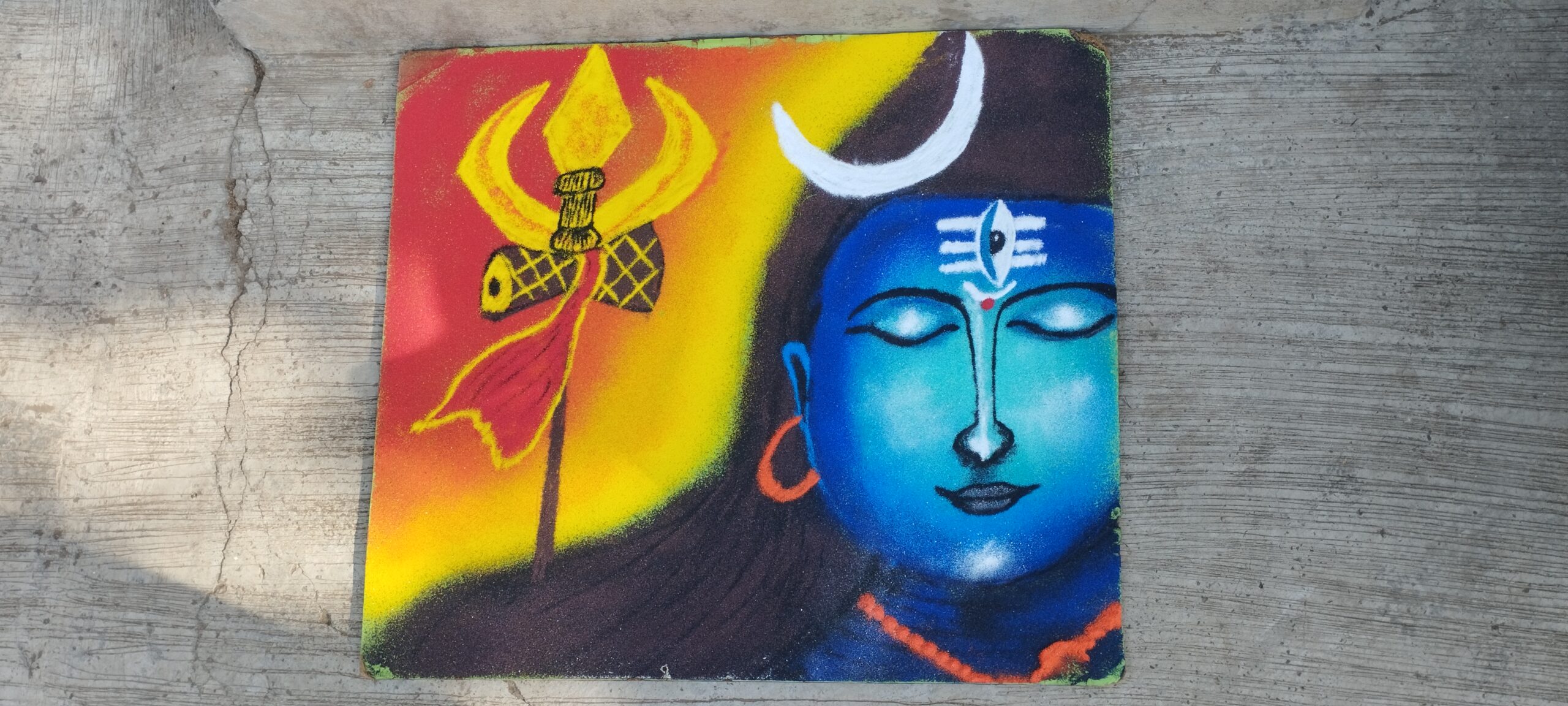Geeta jayanti rangoli- Rangoli of Krishna and Arjuna

Geeta Jayanti: Unveiling the Essence and Celebrating Through Rangoli Art
Introduction
Geeta Jayanti, also known as the day of the advent of the Bhagavad Gita, holds profound significance in Hinduism. This sacred scripture, a conversation between Lord Krishna and the warrior Arjuna on the battlefield of Kurukshetra, serves as a timeless guide to righteous living. As we delve into the importance of Geeta Jayanti, we’ll also explore the tradition of Geeta Jayanti Rangoli and the symbolism behind Rangoli art featuring Krishna and Arjuna.

Geeta Jayanti: Understanding its Importance
1. The Essence of the Bhagavad Gita:
- Geeta Jayanti commemorates the day when Lord Krishna imparted spiritual wisdom to Arjuna, addressing dilemmas related to duty, righteousness, and the path to salvation. The Bhagavad Gita, often referred to as the Gita, is a philosophical and practical guide that transcends time.
2. Universal Relevance:
- The teachings of the Gita are not confined to any particular era or culture. They offer timeless insights into the nature of life, self-realization, and the pursuit of righteousness. Geeta Jayanti serves as a reminder of these universal principles.
3. Ethical and Moral Guidance:
- The Gita provides a comprehensive framework for leading a righteous life. Its verses cover a wide range of topics, including duty, devotion, and the concept of Dharma, which continues to guide individuals on the path of righteousness.
4. Path to Self-Realization:
- Geeta Jayanti emphasizes the importance of self-realization and understanding one’s true nature. Lord Krishna’s teachings encourage individuals to go beyond the superficial aspects of life and connect with their inner self.
Geeta Jayanti Rangoli: A Celebration in Colors
Rangoli, an ancient Indian art form, finds special significance during religious and cultural celebrations. Geeta Jayanti Rangoli is a visual expression of devotion, celebrating the wisdom encapsulated in the Bhagavad Gita.
1. Designing Geeta Jayanti Rangoli:
- Geeta Jayanti Rangoli designs often incorporate symbols from the Bhagavad Gita, such as the lotus representing spiritual purity and the conch shell symbolizing the divine sound. Intricate patterns are crafted to showcase the sacredness of the scripture.
2. Incorporating Scriptural Elements:
- Rangoli artists skillfully integrate verses or snippets from the Gita into the design. This not only adds a textual dimension but also serves as a visual reminder of the scripture’s teachings.
3. Symbolism of Colors:
- Each color in Geeta Jayanti Rangoli holds symbolic significance. White represents purity, yellow symbolizes knowledge, red signifies passion and devotion, and green embodies growth and harmony. The harmonious blending of these colors mirrors the holistic teachings of the Bhagavad Gita.
4. Community Participation:
- Geeta Jayanti Rangoli often becomes a community affair, with families and neighbors coming together to create intricate designs. This communal aspect fosters a sense of unity and shared reverence for the scripture.
Rangoli of Krishna and Arjuna: Symbolic Depictions
1. Depicting the Divine Duo:
- Rangoli featuring Krishna and Arjuna often showcases the iconic moment when Lord Krishna imparts wisdom to Arjuna on the battlefield. The intricate details in their depictions symbolize the depth of the philosophical exchange.
2. Conveying Dialogue Through Art:
- Skilled rangoli artists use fine lines and vibrant colors to portray the nuances of the conversation between Krishna and Arjuna. The expressions and postures convey the emotional and spiritual depth of the Gita’s teachings.
3. Symbolism in Elements:
- Elements like the chariot, the bow, and the celestial backdrop are incorporated into the rangoli, each carrying symbolic meaning. The chariot represents the body, the bow symbolizes determination, and the celestial backdrop signifies the transcendental nature of the discourse.
4. Invoke Spiritual Vibes:
- Rangoli featuring Krishna and Arjuna is not merely an artistic expression; it becomes a medium to invoke spiritual vibes. The colors and patterns create an atmosphere of reverence, inviting individuals to reflect on the profound teachings of the Bhagavad Gita.
Geeta Jayanti is more than an annual observance; it is a timeless celebration of spiritual wisdom. Through Geeta Jayanti Rangoli and depictions of Krishna and Arjuna in rangoli art, devotees visually express their reverence for the Bhagavad Gita. As the colors come together in vibrant harmony, so do the hearts of those who participate, fostering a deep connection with the teachings that transcend the boundaries of time and culture. Geeta Jayanti Rangoli, with its intricate patterns and divine symbolism, serves as a reminder that the essence of the Gita is not confined to the pages of a scripture; it lives on in the hearts and artistic expressions of those who seek its timeless wisdom.



